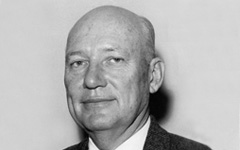- Cite
-
E-mail this Page to a Friend
Your e-mail has been sent!
Please fill in all fields.
[close]
Biography
Irving W. Swanson was born on February 25, 1912, in Hudson, Wisconsin, and attended the local public schools. He attended college at the University of Wisconsin at Madison and at the University of Minnesota, studying history and taking pre-legal coursework. In 1937, he married the former Margaret I. McMurray, who passed away in 2005.
Swanson initially came to Washington in the late-1930s to study law at George Washington University, where he eventually earned his J.D. While a law student, he took a job on Capitol Hill with the Library of Congress’s Legislative Reference Service (the forerunner of the Congressional Research Service). In 1940, he auditioned before House Speaker Sam Rayburn for a reading clerk position in the House and was hired. Swanson served as a minority (Republican) reading clerk in the Office of the Clerk and, after his principal Democratic counterpart fell ill, he shouldered many of the duties at the reading clerk’s desk.
In 1943, Swanson enlisted in the U.S. Navy as a Lieutenant, j. g., and was assigned to a post in Washington, D.C., where he acted as a liaison between the Navy Department and Congress—specializing in procurement issues. In 1945, after a chance encounter with Speaker Rayburn in a Capitol hallway, Swanson was released from military duty and called back to his position as a reading clerk in the House. He remained in that capacity until 1953, when he left to serve as a special assistant for the Majority Secretary of the Senate. After two years, Mr. Swanson took a position as the legislative counsel for the Republican Senatorial Campaign Committee, headed by Senator Barry Goldwater of Arizona. In 1961, Swanson became the assistant for Senate Minority Secretary J. Mark Trice. He left congressional service in 1967, and took a position as a lobbyist for a major pharmaceutical company. He retired in the late-1980s.
Through his decade-long career in the House, Swanson developed a close relationship with Members of the House. Mr. Swanson’s principal duties were to read measures and communications that came before the chamber and, before the advent of electronic voting, taking recorded votes by voice roll calls. But these were not his only tasks. In an era when Members did not have large office staffs to handle and explain complex legislative issues, Representatives often called upon Mr. Swanson to describe legislation that was coming before the floor—what it contained and who was voting for or against it.
In 2005, after his oral history interview, Mr. Swanson donated the gavel used during the session to declare war on Germany and Italy, to the Collection of the U.S. House of Representatives. The gavel is on long-term display in the U.S. Capitol Visitor Center in an exhibit on House history.

